SNOSDB6D December 2020 – October 2024 LMP7704-SP
PRODUCTION DATA
- 1
- 1 Features
- 2 Applications
- 3 Description
- 4 Pin Configuration and Functions
- 5 Specifications
- 6 Detailed Description
- 7 Application and Implementation
- 8 Device and Documentation Support
- 9 Revision History
- 10Mechanical, Packaging, and Orderable Information
Package Options
Refer to the PDF data sheet for device specific package drawings
Mechanical Data (Package|Pins)
- HBH|14
Thermal pad, mechanical data (Package|Pins)
Orderable Information
6.3.4 Capacitive Load
The LMP7704-SP can be connected as a noninverting unity gain follower. This configuration is the most sensitive to capacitive loading.
The combination of a capacitive load placed on the output of an amplifier along with the amplifier output impedance creates a phase lag, which in turn reduces the phase margin of the amplifier. If the phase margin is significantly reduced, the response is either underdamped or oscillated.
To drive heavier capacitive loads, use an isolation resistor, labeled as RISO in Figure 6-2. By using this isolation resistor, the capacitive load is isolated from the amplifier output, and thus, the pole caused by CL is no longer in the feedback loop. The larger the value of RISO, the more stable the output voltage. If values of RISO are sufficiently large, the feedback loop is stable, independent of the value of CL. However, larger values of RISO result in reduced output swing and reduced output current drive.
 Figure 6-2 Isolating Capacitive Load
Figure 6-2 Isolating Capacitive Load